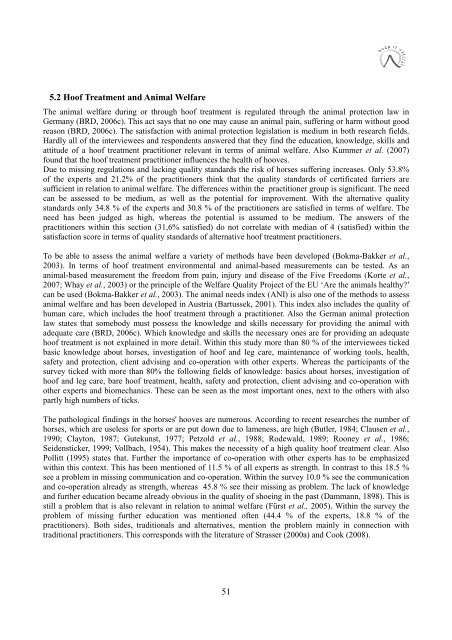Bachelor Thesis - Christina Kuenen - Hufpfleger
Bachelor Thesis - Christina Kuenen - Hufpfleger
Bachelor Thesis - Christina Kuenen - Hufpfleger
Create successful ePaper yourself
Turn your PDF publications into a flip-book with our unique Google optimized e-Paper software.
5.2 Hoof Treatment and Animal Welfare<br />
The animal welfare during or through hoof treatment is regulated through the animal protection law in<br />
Germany (BRD, 2006c). This act says that no one may cause an animal pain, suffering or harm without good<br />
reason (BRD, 2006c). The satisfaction with animal protection legislation is medium in both research fields.<br />
Hardly all of the interviewees and respondents answered that they find the education, knowledge, skills and<br />
attitude of a hoof treatment practitioner relevant in terms of animal welfare. Also Kummer et al. (2007)<br />
found that the hoof treatment practitioner influences the health of hooves.<br />
Due to missing regulations and lacking quality standards the risk of horses suffering increases. Only 53.8%<br />
of the experts and 21.2% of the practitioners think that the quality standards of certificated farriers are<br />
sufficient in relation to animal welfare. The differences within the practitioner group is significant. The need<br />
can be assessed to be medium, as well as the potential for improvement. With the alternative quality<br />
standards only 34.8 % of the experts and 30.8 % of the practitioners are satisfied in terms of welfare. The<br />
need has been judged as high, whereas the potential is assumed to be medium. The answers of the<br />
practitioners within this section (31,6% satisfied) do not correlate with median of 4 (satisfied) within the<br />
satisfaction score in terms of quality standards of alternative hoof treatment practitioners.<br />
To be able to assess the animal welfare a variety of methods have been developed (Bokma-Bakker et al.,<br />
2003). In terms of hoof treatment environmental and animal-based measurements can be tested. As an<br />
animal-based measurement the freedom from pain, injury and disease of the Five Freedoms (Korte et al.,<br />
2007; Whay et al., 2003) or the principle of the Welfare Quality Project of the EU ‘Are the animals healthy?’<br />
can be used (Bokma-Bakker et al., 2003). The animal needs index (ANI) is also one of the methods to assess<br />
animal welfare and has been developed in Austria (Bartussek, 2001). This index also includes the quality of<br />
human care, which includes the hoof treatment through a practitioner. Also the German animal protection<br />
law states that somebody must possess the knowledge and skills necessary for providing the animal with<br />
adequate care (BRD, 2006c). Which knowledge and skills the necessary ones are for providing an adequate<br />
hoof treatment is not explained in more detail. Within this study more than 80 % of the interviewees ticked<br />
basic knowledge about horses, investigation of hoof and leg care, maintenance of working tools, health,<br />
safety and protection, client advising and co-operation with other experts. Whereas the participants of the<br />
survey ticked with more than 80% the following fields of knowledge: basics about horses, investigation of<br />
hoof and leg care, bare hoof treatment, health, safety and protection, client advising and co-operation with<br />
other experts and biomechanics. These can be seen as the most important ones, next to the others with also<br />
partly high numbers of ticks.<br />
The pathological findings in the horses' hooves are numerous. According to recent researches the number of<br />
horses, which are useless for sports or are put down due to lameness, are high (Butler, 1984; Clausen et al.,<br />
1990; Clayton, 1987; Gutekunst, 1977; Petzold et al., 1988; Rodewald, 1989; Rooney et al., 1986;<br />
Seidensticker, 1999; Vollbach, 1954). This makes the necessity of a high quality hoof treatment clear. Also<br />
Pollitt (1995) states that. Further the importance of co-operation with other experts has to be emphasized<br />
within this context. This has been mentioned of 11.5 % of all experts as strength. In contrast to this 18.5 %<br />
see a problem in missing communication and co-operation. Within the survey 10.0 % see the communication<br />
and co-operation already as strength, whereas 45.8 % see their missing as problem. The lack of knowledge<br />
and further education became already obvious in the quality of shoeing in the past (Dammann, 1898). This is<br />
still a problem that is also relevant in relation to animal welfare (Fürst et al., 2005). Within the survey the<br />
problem of missing further education was mentioned often (44.4 % of the experts, 18.8 % of the<br />
practitioners). Both sides, traditionals and alternatives, mention the problem mainly in connection with<br />
traditional practitioners. This corresponds with the literature of Strasser (2000a) and Cook (2008).<br />
51


